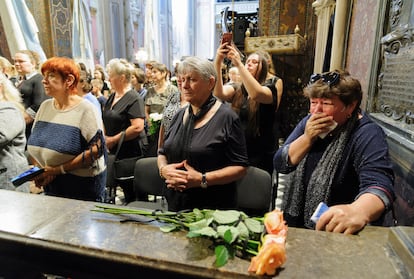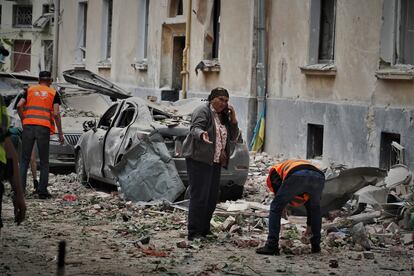Aftermath of a massacre: Lviv’s civilians remain in shock from Russian bombardment
The capital of western Ukraine, a short distance from NATO territory, is still reeling from the July 6 air strike, which killed 10 people and wounded 48


The paradoxes of war: Andri Sadovi, the mayor of Lviv in western Ukraine, says that he is in contact with UNESCO officials; that he is negotiating with them to secure aid to repair what was destroyed during the Russian bombardment of July 6 because his city is a world heritage site, and that reconstruction will be somewhat slower because it has to follow United Nations standards. Despite the UNESCO seal of protection, Moscow targeted Lviv with air strikes at around 2 a.m. that Thursday morning. And precisely because of Lviv’s UNESCO status, the restoration must follow a road map: “You can’t just change one window for another,” says Sadovi. Ten people lost their lives in the attack and 48 more were wounded.
Lviv, located some 70 kilometers (43 miles) from NATO and EU territory and one of the safest cities in war-time Ukraine, nonetheless was the target of one of the deadliest attacks against the civilian population since the beginning of the Russian invasion. The dead, aged between 32 and 70, were buried but the shockwave of that missile still resonates today: the psychological trauma of the survivors is compounded by the lack of hope of returning to their homes.
Hanna Fedorenko, 76, is an example of this truth: that a massacre does not end when the rescue efforts conclude. Fedorenko cares for her three grandchildren (aged 10, 18 and 20), who were orphaned after the death of their parents due to health reasons. She remembers well what happened that July morning after hearing the anti-aircraft sirens: “I was with the children and one of the older ones told me to go to the corridor [one of the recommendations in the face of a possible attack, if you can’t get to a shelter, is to place yourself between two walls],” she recounts. “I went to get the cat, which was leaning against the window, and that’s when the missile hit.” The woman covered the youngest of her grandchildren with her body. The impact of the projectile blew out the glass, which landed on Fedorenko. Her right cheek bears a scar left by the handful of stitches that closed up one of her wounds.
This family, like many of those whose homes were damaged, now lives in temporary housing units erected in Striski Park. About 500 meters away, workers, almost a month later, are still removing the debris left by the bombing. Fedorenko knows that her house suffered structural damage, that almost all of the furniture was destroyed and that it will be difficult to return any time soon. The local authorities help those forced from their homes to find rented accommodation, but prices are sky-high in a city where hundreds of thousands of internally displaced persons have arrived.
For the Fedorenko family there is a bigger challenge: the youngest child has to attend a special education center in the same district, so options are even more limited. The shock wave is compounded by trauma: “I feel better now,” says the grandmother of the three siblings. “I am afraid of hearing the sirens, but my granddaughter is even more afraid, because she doesn’t even want to leave the house.”
The attack also came as a “shock” for Mayor Sadovi, 54, who has been in office since 2006 and who ran for the presidential race that was won four years ago by a television comedian named Volodymyr Zelenskiy. Sadovi is a tall man, solicitous, but restless and with an agenda that is difficult to pursue. He reviews, in a conversation with EL PAÍS between his offices and the city’s streets, the destruction of July 6: four buildings, 60 houses, 3,000 windows, schools, kindergartens, student residences...
UNESCO recognizes the historic center of Lviv, about three kilometers (1.8 miles) from the epicenter of the Russian bombardment, as a world heritage site. But the organization includes in the same bag what it calls “buffer zones” nearby, and that is where the corner between Akademika Sakharova and Striska streets, devastated by missiles, would fall. Sadovi underlines the complexity of following the requirements of the United Nations-dependent organization. “It is more difficult to restore a building in a UNESCO zone than to build a new one.” The mayor estimates the cost of rebuilding everything damaged at 200 million grivnas (around $5.5 million). “That’s a lot of money for my City Hall,” he notes.

War crime
It is also difficult to keep track of what is clearly a war crime under international law. In Lviv, the Prosecutor’s Office and the police have taken charge of the investigations. Human Rights Watch researcher Yulia Gorbunova published the results of her work two weeks ago after interviewing 22 residents and viewing 29 videos and 232 photographs, as well as satellite images. The New York-based organization claims that, that night, three Russian missiles were directed towards the area, two of which hit military targets about 300 meters away from residential houses, while the third hit the civilian buildings. The projectiles were Kalibr cruise missiles, a modern and — at least on paper — highly accurate weapon because of its trajectory guidance systems. Moscow maintains that it does not attack civilian targets.
Liubov Polovko, 64, lived on the second floor of the building hit by that third Kalibr missile. He says that it is a neighborhood where almost everyone knows each other; there is friendship. Indeed, the houses are built around a small square with a children’s playground in the middle. Polovko knew all the victims. “When we heard the alerts, my husband went to close the window [another of the recommendations in case of an attack] and told me to go to the kitchen.” They didn’t meet there because the missile struck at that moment, sending them both flying. “I didn’t know what had happened, I didn’t even realize our building had been hit,” the woman says. The bomb blew out the doors and windows. They had been living there for 33 years and are now housed in the Striski Park modules. Polovko does not believe that the building will be restored within the next year. Asked if she has received psychological assistance after the attack, she replies: “Yes, but I don’t need it. I am strong.”
Not so Irina Chmir, 47. She admits that when she hears warnings of possible attacks she feels “panic” because she expects another strike to come. Chmir has received psychological assistance from Italian specialists. She lives with her parents in the prefabricated huts of Striski Park, which was designed in Soviet times. The three previously lived on the second floor of the building on Striska street; they had time to reach the corridor before the missile hit the top of the building. Her mother suffered cuts to her head and arms from broken glass in the blast and hit her back when she fell. “It’s hard to remember that,” says Chmir, parsimoniously. She has been assured by the authorities, as have her neighbors, that their homes will be restored, but it is difficult to envisage when that will happen. She would like to rent a house, but she has no money, despite donations from overseas NGOs.
Something changed in the mood in Lviv, the safe capital of western Ukraine, on July 6. “Compared to Kherson, Mykolaiv, Kharkiv or Dnipro,” Sadovi points out, “Lviv remains a city of maximum security.” Nevertheless, the mayor insists again on the mantra drummed into Lviv’s citizens since the beginning of the Russian invasion, on February 24, 2022: in case of air raid warnings, go to the shelters.
Sign up for our weekly newsletter to get more English-language news coverage from EL PAÍS USA Edition
Tu suscripción se está usando en otro dispositivo
¿Quieres añadir otro usuario a tu suscripción?
Si continúas leyendo en este dispositivo, no se podrá leer en el otro.
FlechaTu suscripción se está usando en otro dispositivo y solo puedes acceder a EL PAÍS desde un dispositivo a la vez.
Si quieres compartir tu cuenta, cambia tu suscripción a la modalidad Premium, así podrás añadir otro usuario. Cada uno accederá con su propia cuenta de email, lo que os permitirá personalizar vuestra experiencia en EL PAÍS.
¿Tienes una suscripción de empresa? Accede aquí para contratar más cuentas.
En el caso de no saber quién está usando tu cuenta, te recomendamos cambiar tu contraseña aquí.
Si decides continuar compartiendo tu cuenta, este mensaje se mostrará en tu dispositivo y en el de la otra persona que está usando tu cuenta de forma indefinida, afectando a tu experiencia de lectura. Puedes consultar aquí los términos y condiciones de la suscripción digital.
More information
Archived In
Últimas noticias
Maduro pleads not guilty before the federal court in New York: ‘I am still the president of Venezuela’
A new test can detect Alzheimer’s from a finger prick
UN team enters Sudanese city of El Fasher after paramilitary massacre: ‘It’s like a ghost town’
A recipe for resistance: Indigenous peoples politicize their struggles from the kitchen
Most viewed
- Gilles Lipovetsky: ‘If you want to live better and fall in love, take Prozac, don’t look to philosophy’
- Alain Aspect, Nobel laureate in physics: ‘Einstein was so smart that he would have had to recognize quantum entanglement’
- Alvin Hellerstein, a 92-year-old judge appointed by Bill Clinton, to preside over Maduro’s trial in New York
- Why oil has been at the center of Venezuela-US conflicts for decades
- Maduro’s downfall puts China’s relationship with Venezuela to the test








































